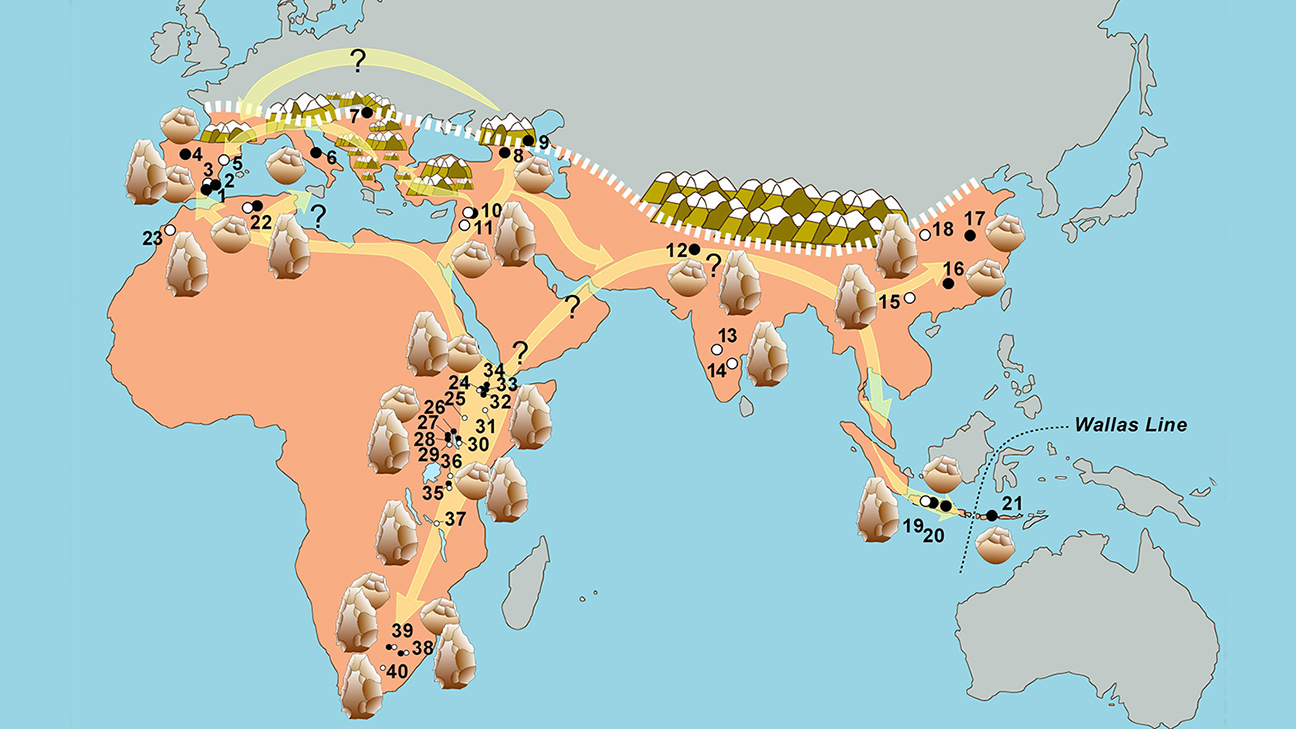Redating of five fossils from southeastern Spain places these as comfortably the oldest evidence of hominids in Europe. If correct, this provides strong evidence for the claim that members of the Homo genus first reached Europe by crossing the open water between Morocco and Gibraltar, implying a level of technological sophistication previously thought to have evolved much later. Astonishing as such a conclusion would be, it is consistent with several other recent discoveries from around the world.
Long before our species, Homo sapiens, appeared on Earth, other hominids had left Africa and populated much of Asia and Europe. Although the ancestors we share with these explorers were making stone tools more than a million years earlier than that, it was initially assumed Eurasia was populated entirely on foot. The idea that Homo erectus or its contemporaries could build boats or swim long distances was treated as a non-starter.
If that was true, therefore, the path into Europe would have required passing through parts of Asia and around the Black Sea before moving west. The dating of remains from Orce, Granada as 1.3 million years old contradicts that, being far older than any from Eastern or Central Europe.
Dr Lluis Gibert of the University of Barcelona is lead author of a new attempt to date these fossils using the magnetic records in sediments in which the fossils were found. Magnetic rocks preserve a record of the direction of the magnetic field in which they formed. Occasional reversal of the Earth’s poles allows paleontologists to date these rocks with more confidence than most alternative methods.
Outcrops in the Orce region are perfect for this, Gibert claims. “The uniqueness of these sites is that they are stratified and within a very long sedimentary sequence, more than eighty meters long. Normally, the sites are found in caves or within very short stratigraphic sequences, which do not allow you to develop long paleomagnetic sequences in which you can find different magnetic reversals,” he said in a statement.
Based on their placement relative to five such reversals, fossils from Venta Micena, Barranco León and Fuente Nueva are respectively 1.32, 1.28, and 1.23 million years old. That puts these Orce sites as 200,000-400,000 years older than the alternative oldest site of hominid occupation on the Iberian Peninsula. More significantly, it makes all of them far older than any hominid fossils elsewhere in Europe.
Unless an error can be found in Gibert and co-authors’ dating, early humans either passed all the way from the Caucuses to Spain without leaving any trace, or they arrived there via the Strait of Gibraltar. Both are hard to believe, but Gibert and the other authors consider the second option much more likely.

The area occupied by early humans 700,000 years ago (salmon), with sites where remains or tools have been found. Possible migration paths are marked in yellow, notably those by which humans could have reached Spain.
Image Credit: Gibert et al/Earth Science Reviews
We know hominids can live in an area for a long time without leaving any fossils – or at least none we have found. Yet if humans had been spread out across at least southern Europe for hundreds of thousands of years, we’d have expected to find something. The alternative possibility, that hominids migrated through eastern and central Europe, and then France, but didn’t stay long enough to leave traces before flourishing in Spain, is equally implausible.
This leaves the idea that the ancestors of the Orce fossils crossed the Mediterranean, presumably at the Strait where it is currently 14 kilometers (8 miles) wide. The similarity of stone tools at one Orce site to those being made in North Africa around the same time strengthens the claim.
Meanwhile, the oldest evidence of the Acheulian technology, developed by Homo erectus and continued by Neanderthals, lies beneath layers at most 1.07 million years old. Between 0.91 and 0.78 million years ago Acheulian technology appears in Italy as well as Spain, suggesting this was the point where hominids entered Europe from the east.
Nevertheless, the question remains how anyone could have crossed the Strait?
We know the Strait has been blocked at times, but the most recent was millions of years before the first humans, so passage on dry land was not possible. On the other hand, tectonic activity in the area means the width of the Strait has grown and shrunk over time, so it might once have been a shorter passage than it is today.
Nevertheless, the powerful currents make it very unlikely the Strait was swimmable at the time, suggesting anyone crossing the Strait must have had a boat or raft.
This would also explain how the ancestors of Homo floresiensis, the so-called “Hobbits” crossed the even wider – 19 kilometers (11 miles) or more – Lombok Strait. “Humanity arrived in Europe when it had the necessary technology to cross maritime barriers, as happened before a million years ago on the island of Flores (Indonesia),” Gibert said.
The possibility of such early, and relatively small-brained, human ancestors making steerable watercraft became more credible with the discovery of a wooden structure 476,000 years old, before Homo sapiens.
If more than a million years ago early humans were building wooden houses and vessels capable of crossing treacherous waters, we have to ask: What else they could do? Equally puzzling is why people capable of such advanced technology apparently never developed some technologies and cultural practices that finally burst on the scene in the Neolithic.
The study is open access in Earth-Science Reviews.
Source Link: Oldest European Hominid Remains Indicate Early Humans Crossed Strait Of Gibraltar